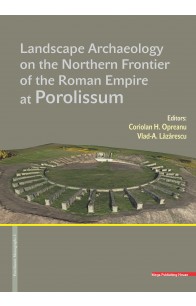Rezultate căutare pentru 'Adrian Ursu��iu'
„Ce second supplément des Inscriptiones Daciae Romanae représente, tout comme le premier, une préparation à la publication des fascicules du quatrième volume des IDR, contenant les inscriptions de Dacie Porolissensis. Il comprend la grande majorité des estampilles sur briques et tuiles du Musée National d’Histoire de Transylvanie de Cluj-Napoca. Malheureusement, pour des raisons techniques, nous n’avons pas eu accès aux pièces prêtées en 1971 au Musée National d’Histoire de Roumanie de Bucarest, lors de la constitution de celui-ci1. Au fil de plusieurs années Mme Viorica Rusu Bolindeț avait apporté dans le dépôt du musée des dizaines de tuiles estampillées du prétoire du consulaire d’Apulum, mais on n’a pas pu agréer aucune solution afin de citer son manuscrit. Du point de vue scientifique la perte n’est pas grande, car il s’agit de types bien connus, publiés dans IDR III/6. En revanche, nous remercions chaleureusement Mme Adriana Isac pour nous avoir permis d’utiliser toutes les pièces provenant du camp de Gilău, dont certaines inédites. Au début de 1997 des tuiles estampillées représentatives ont été envoyées au musée de Zalău en vue d’une exposition illustrant la vie militaire dans le nord de Dacie. Elles n’ont plus été restituées. Afin d’éviter des problèmes administratifs, on les a inclues dans le premier supplément, qui contient les inscriptions sur les briques et les tuiles du musée de Zalău. Le présent volume ne représente pas moins un catalogue du musée de Cluj.” (Prooemium)
„The history of the Roman auxilia was for the first time closely examined by C. Cichorius. An early attempt to discuss various topics and aspects related to the place and role of the auxiliary units in the Roman army belongs to G. L. Cheesman. For the study herein, of great significance are the studies of W. Wagner and K. Kraft4, who tackle, others also the units active on the territory of Moesia Superior. J. Beneš approaches the issue of auxiliaries from the two Moesiae and the Dacian provinces, initially in a 1970-study and then in a monograph issued in 1978.
In 1980, P. A. Holder also contributed an article to the basic reference work on the topic of Roman auxilia and their history in the Roman empire during the 1st century AD at a time when the evidence was limited (to some degree represented by military diplomas) and difficult to interpret together with our knowledge on the history auxiliary units known later to be stationed in the mentioned provinces. The special importance of the study consists in the attempt to equate the units recorded in the 1st century with those attested with certainty through 2nd century-military diplomas. The approach has been recently furthered by the publication of two overviews on the displacement of the auxiliaries under Trajan and Hadrian.” Introduction
„În urmă cu mai bine de 30 de ani, în timpul uceniciei pe șantierele arheologice ale profesorului Gheorghe Lazarovici, ne-am întâlnit pentru prima dată cu studiile interdisciplinare între arheologie și etnografie, religie etc. La vremea respectivă am considerat aceste inițiative drept un pionierat fără o finalitate în cercetarea fundamentală. La cercetările organizate de profesorul Gheorghe Lazarovici am avut onoarea să-l cunosc pe John Nandriș, care ne-a descchis drumul către această cercetare interdisciplinară. Remarc în mod deosebit aportul de nepreţuit al prof. univ. dr. John Nandriş care pe lângă faptul că a făcut posibilă implementarea unui proiect cu tematică etnoarheologică în România acelor ani a atras atenţia întregii lumi ştiinţifice asupra zonei de sud-est a Europei, mai ales a zonei muntoase înalte a munţilor din România, zone prea puţin explorate. Muzeul pe care astăzi îl conduc are bucuria de a prezenta specialiștilor, și nu numai, o serie de studii aprofundate ale acestui domeniu. Instituția noastră, pe lângă preocupările arheologice, acordă o atenție deosebită cercetărilor etnografice din spațiul Banatului de Munte. (..)
Volumul de față reunește studii deosebit de importante din ultimii 30 de ani, care deschid o nouă perspectivă asupra interdisciplinarității arheologice. Prezenta lucrare este o sinteză a unei munci asidue din partea unor cercetători de renume, care valorifică bogatul patrimoniu arheologic şi etnografic al spaţiului românesc. ” - dr. Adrian Ardeț
„The frontiers of the Roman Empire, over 5000 km long, stretch from the Atlantic coast of Scotland, along the Rhine and the Danube, also enclose the Banat region and Transylvania, then going down along the Oriental Carpathians to the Black Sea; from the southern coast of the Black Sea they continue towards the Near East until the Red Sea; then, in North Africa, they line the edge of the Sahara desert until the Atlantic coast of Morocco. Over this entire area, visible traces of fortifications, roads and settlements are still preserved, but numerous monuments still lay hidden underneath the earth. Despite the fact that the Roman frontiers crossed regions with different relief and climate, they constitute a whole in that they were designed to protect Roman territories. The research of these monuments and the preservation policy regarding them was and is unequal in the various presentday states on whose territory traces of the Roman frontier are to be found. Consequently, in the ‘80s of the 20th century, the idea of globally protecting the Roman frontiers, viewed as a unitary monument, was met. In 1987, Hadrian’s Wall in United Kingdom was declared a UNESCO monument. It was followed in 2005 by the German-Raetian sector, on which occasion the UNESCO committee decided to set up the ‘Frontiers of the Roman Empire’ site. (...)
This project through its complexity generated an interdisciplinary approach of the proposed subject stimulating such future attempts in the archaeological research field. By using the latest technical methods of non-destructive investigation the project did not damage the stratigraphy of the archaeological site obtaining instead a high amount of data otherwise time consuming judging from the archaeological excavations perspective contributing also to the preservation of the cultural heritage.” - Introduction







